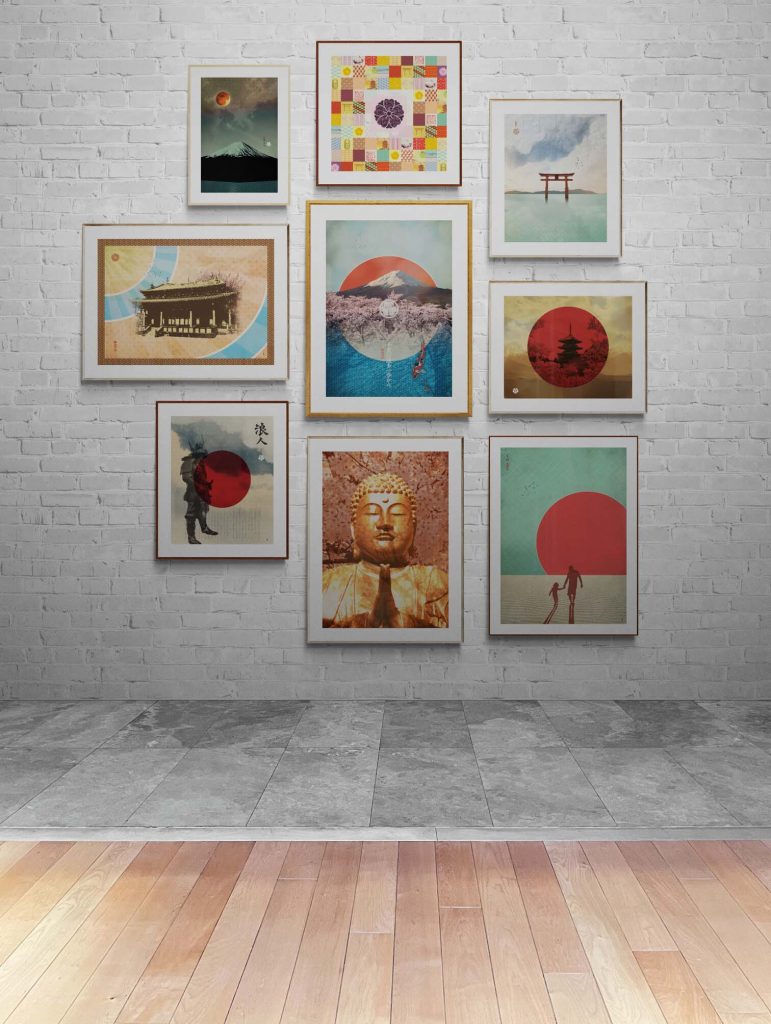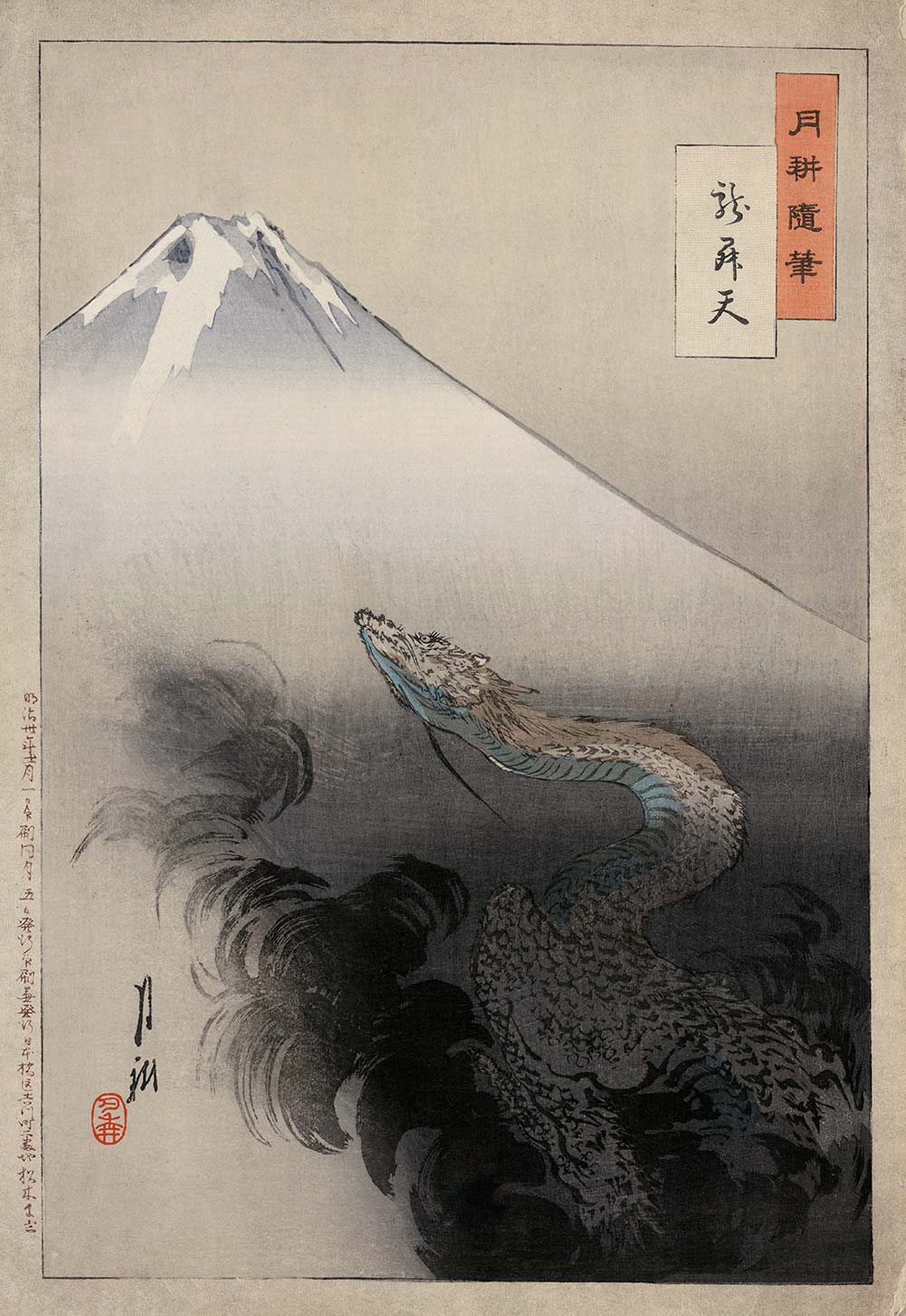Mount Fuji Wall Art.
A collection of Mount Fuji art prints.
Our collection of Mount Fuji art prints is reminiscent of the traditional Japanese woodblock prints and Ukiyo-e art.
Each of the Giclee art prints below has been constructed with a modern color palette, incorporates traditional Japanese patterns (wagara), and includes a relevant saying, which helps tell the story of the artwork.
At The Art of Zen we carry original art prints inspired by traditional Japanese designs. There are a variety of premium art prints and digital downloads available in the online store, and bespoke/custom art installations are possible. Our prints are digitally printed using museum quality archival inks on premium matte paper imported from Japan.
Bring some Japandi style to your home, business, or office with our Japandi wall art.
Read more about The Art of Zen story, and about traditional ukiyo-e art on our blog.
The Sky Over Mt Fuji
On a magical night, a magenta aura permeates through the sky, changing the color spectrum of the landscape.
Where land meets water, a double belt of Genji-mon adorns. These rectangular emblems are associated with one of the 54 chapters of the Genji monogatari (“Tale of Genji,”) which is widely considered to be the world’s first novel.
This gorgeous limited edition print is part of our Mount Fuji wall art series.
Details:
- Limited edition run of 299
- Giclee print on matte paper imported from Japan
- Size in cm: 50 cm x 70 cm
- Size in inches: 19.69 in x 27.56 in
Fujimar
The majestic Mount Fuji rises more than 12,000 feet towards the sky, the tallest summit in Japan. The Fujimar art print celebrates this sacred mountain and the surrounding Japanese area.
This Mount Fuji artwork also features the Rising Sun, sakura kamon, sakura trees, and koi fish.
Inscribed in the bottom center is a Japanese proverb:
“Even a journey of a thousand miles begins with the first step.”
Details:
- Limited edition run of 499
- Giclee print on matte paper imported from Japan
- Size in cm: 50 cm x 70 cm
- Size in inches: 19.69 in x 27.56 in
Full Moon Night Over Mt Fuji
Flower, Bird, Wind, Moon (花鳥風月) is a Japanese saying on which this gorgeous print is loosely based.
Experience the wonders of Nature, and in doing so discover about yourself.
This Mount Fuji art print features a rare Full Red Moon in the night sky, as the glorious Mount Fuji juts up from the foreground. A traditional Japanese pattern developed from a kamon (family crest) adorns the background.
Details:
- Limited edition run of 499
- Giclee print on matte paper imported from Japan
- Size in cm: 30.48 cm x 45.72 cm
- Size in inches: 12 in x 18 in
Mount Fuji at Dusk and at Dawn
This beautiful set of Mount Fuji prints are entitled Mount Fuji at Dusk (Blue) and Mount Fuji at Dawn (Pink).
Mt Fuji is the central character of this work surrounded by the Rising Sun or by the Rising Moon depending on the version.
The traditional Japanese wagara pattern of Kikko is used in the top half, adding geometry and symmetry to contrast the organic lines of Mount Fuji.
In the bottom half of the both prints is an inscription of this relevant Japanese proverb:
富士山に登らぬ馬鹿、二度登る馬鹿
which loosely translates as “a wise man climbs Mount Fuji once, only a fool would climb it twice.”
Details:
- Available in 5 different sizes
- Limited edition of 50 prints per size for a total edition of 250 for each version
- Giclee print on matte paper imported from Japan
Mount Fuji in Japanese Art: A Majestic Icon Through the Ages.
Mount Fuji, or Fuji-san as it is affectionately known in Japan, is an enduring symbol of natural beauty, spiritual significance, and cultural heritage.
This iconic stratovolcano, which stands at 3,776 meters (12,389 feet), holds a special place in Japanese culture and has been immortalized in countless Japanese art prints.
In this exploration, we delve into the profound significance of Mt Fuji in Japanese culture, with a primary focus on its portrayal in the exquisite world of Japanese art, including the renowned ukiyo-e works of Katsushika Hokusai and contemporary artist Ohata.
Ukiyo-e, which translates to “pictures of the floating world,” is a genre of Japanese woodblock prints and paintings that flourished during the Edo period (17th to 19th centuries).
It is in this art form that Mount Fuji found a lasting home.
Specifically, we take a look at two great Japanese ukiyo-e artists who created inspiration works of Mount Fuji art.
Hokusai’s “Thirty-Six Views of Mount Fuji”
Katsushika Hokusai (1760 – 1849), one of Japan’s most celebrated ukiyo-e artists, created his iconic series “Thirty-Six Views of Mount Fuji” between 1830 and 1833. The series consists of—you guessed it—36 prints that showcase Mount Fuji from various angles, seasons, and vantage points. One of the most famous prints from the series is “The Great Wave off Kanagawa,” which features a towering wave in the foreground and Mount Fuji in the background, a visual masterpiece that has become a global symbol of Japanese art. It is also the most expensive ukiyo-e art sold at auction.
Hokusai’s work in this series was revolutionary in its approach. He depicted the mountain not only as a symbol of tranquility but also as a dynamic force in its own right. Hokusai’s exploration of Mt Fuji in different contexts—from serene landscapes to turbulent seascapes—reflects its multifaceted significance in Japanese culture.
Ogata Gekkō’s “One Hundred Views of Mount Fuji”
Ogata Gekkō (1859 – 1 October 1920), a self-taught artist, known for the series Fuji hyakkei (富士百景) or One Hundred Views of Mount Fuji.
Gekkō’s famous Mt Fuji woodblock print, Ryūshōten (龍昇天) is shown here and depicts a dragon rising towards the Heavens with Mt Fuji in the background.
Collectively, both Hokusai and Gekkō’s work have been the inspiration behind The Art of Zen Mount Fuji print series.
While Katsushika Hokusai’s “Thirty-Six Views of Mount Fuji” remains a cornerstone of Fuji’s artistic legacy, contemporary artists continue to find inspiration in this iconic symbol. Hiroshi Senju, a celebrated contemporary Japanese painter, is one such artist. His work brings a fresh perspective to the enduring allure of Mount Fuji.
Senju’s acclaimed “Waterfall” series is a prime example of his unique approach. In this series, he skillfully blends traditional Japanese techniques with modern abstraction. One standout piece, titled “Waterfall 04-9,” features a dynamic waterfall crashing into a serene pool, with Mount Fuji subtly emerging in the background. The juxtaposition of movement and stillness, vividness and tranquility, captures the mountain’s ever-changing presence.
Senju’s work resonates with viewers by reimagining Mount Fuji in a contemporary context. Through his art, he reminds us that the mountain’s beauty and significance persist, even as Japan embraces modernity.
Senju is not the only contemporary artist drawn to Mount Fuji’s majesty. Artists like Takashi Murakami (see Vogue Japan cover image), renowned for his distinctive style of Superflat art, have also incorporated the mountain into their work. Murakami’s colorful and playful interpretation of Mount Fuji reflects the enduring appeal of this iconic symbol across generations.
In addition, contemporary photographers like Hiroshi Sugimoto have captured Mount Fuji’s essence through the camera lens. Sugimoto’s minimalist photographs, featuring the mountain in its serene glory, evoke a sense of timelessness and reverence.
For those who wish to bring the timeless beauty of Mount Fuji into their living spaces, Mount Fuji wall art offers a compelling option. Whether it’s a traditional woodblock print or a contemporary interpretation, Mount Fuji art can transform your walls into a canvas of cultural significance.
Mount Fuji’s significance in Japanese culture and art continues to evolve with the times. Contemporary artists like Hiroshi Senju, Takashi Murakami, and Hiroshi Sugimoto bring fresh perspectives to this timeless symbol. Through their work, they demonstrate that Mount Fuji remains a powerful muse, seamlessly bridging the gap between tradition and modernity.
Whether captured through paint, photography, or abstraction, Mount Fuji continues to inspire and captivate, serving as a testament to the enduring connection between nature, culture, and contemporary art in Japan. Whether you seek Mount Fuji wall art or simply wish to appreciate its profound symbolism, the mountain’s legacy endures, transcending generations and artistic expressions.










